Sergeant Jerry Shriver
BY Herschel SmithThis is the most awesome fact I found the entire weekend. Jerry Shriver, of MACV-SOG in Vietnam, carried a Marlin 444 lever action rifle.
This is the most awesome fact I found the entire weekend. Jerry Shriver, of MACV-SOG in Vietnam, carried a Marlin 444 lever action rifle.
Ahead of the event, Anime NYC advertised the Marines making an appearance (Booth #373) as “a military partner,” linking to an enlistment form for applicants to connect with a Marines recruiter. (The recruitment application on the official Marines website included the UTM code, “FY23ANIMECON,” in order to track the social media campaign’s performance across platforms.)
According to the exhibitor list, the Army (Booth #367) touted a 360-degree photobooth, oft-used at high school dances and wedding venues; a personalized dogtag-making station; and military “swag” to take home. “Join like-minded Army personnel who share a passion for anime and discover what the Army can offer you. With over 170 career paths, robust education benefits, and exciting job opportunities, the Army is a wide-open frontier to helping you Be All You Can Be!” reads the Anime NYC description.
I would expect that of the Army and the FBI (who was recruiting there too). That the Marines were there is embarrassing for them.
How shameful. Even now they cannot understand why good men no longer want to fight and potentially perish for the country. It is no longer their country.
Leaders of Marine units can let their service members wear nonstandard uniform items amid a long-term shortage of the regular camouflage uniform.
The Marine Corps says it won’t have a full stock of the woodland-pattern camouflage combat utility uniform ― the everyday outfit for most Marines ― until summer or fall 2024. The shortage has prompted the top Marine leader to authorize unit commanders to allow the desert-colored camouflage combat utility uniform or the flame-resistant organizational gear, known as FROGs.
Ridiculous. This is because of lack of planning, lack of logistics, lack of vision, lack of foresight, and lack of funding, along with worrying about the wrong things like gender and race studies.
U.S. Army from Glenn Reynolds.
NEGLECTING THE TROOPS: Congress blasts Pentagon for ‘dreadful’ barracks conditions. “In a scathing letter addressed to Secretary of Defense Lloyd Austin, lawmakers accused the Pentagon of failing to ‘provide the most basic oversight and care’ of barracks at 10 installations cited in a recent report and called it a ‘failure of leadership’ by Austin ‘that cannot be ignored.’”
I have a nephew in the Army and have heard a number of stories along these lines — no food, no toilet paper, filthy barracks, etc.
If living quarters – whether barracks or tent – aren’t squared away, that’s the fault of leadership. If the troops are filthy or live in filthy conditions, there is a lack of discipline.
Either way, there is a general lacking that deeply affects the U.S. military.
And it’s all by design, you understand?
What do you want to bet this lack of discipline doesn’t affect the Mexican cartels or the army of Communist China?
Commentary at Army Times:
On all key technical measures, the Next Generation Squad Weapons program is imploding before Army’s very eyes. The program is on mechanical life support, with its progenitors at the Joint Chiefs obstinately now ramming the program through despite spectacularly failing multiple civilian-sector peer reviews almost immediately upon commercial release.
Indeed the rifle seems cursed from birth. Even the naming has failed. Army recently allowed a third-party company to scare it off the military designation M5. The re-naming will certainly also help scupper bad public relations growing around ‘XM-5′ search results.
Civilian testing problems have, or should have, sunk the program already. The XM-5/7 as it turns out fails a single round into a mud test. Given the platform is a piston-driven rifle it now lacks gas, as the M-16 was originally designed, to blow away debris from the eject port. Possibly aiming to avoid long-term health and safety issues associated with rifle gas, Army has selected an operating system less hardy in battlefield environments. A choice understandable in certain respects, however, in the larger scheme the decision presents potentially war-losing cost/benefit analysis.
Watch the mud test video above. It’s possible to tailor demonstrations and testing to sell any product, and that’s what many manufacturers do in Military arms contracts award trials. And there’s almost always a high-level ringer in uniform to urge his peers into acceptance.
Civilian testing, testing Army either never did or is hiding, also only recently demonstrated that the rifle seemingly fails, at point-blank ranges, to meet its base criteria of penetrating Level 4 body armor (unassisted). True, the Army never explicitly set this goal, but it has nonetheless insinuated at every level, from media to Congress, that the rifle will penetrate said armor unassisted. Indeed, that was the entire point of the program. Of course, the rounds can penetrate body armor with Armor Piercing rounds, but so can 7.62x51mm NATO, even 5.56x45mm NATO.
Everybody knew outsourcing manufacturing would have dire national consequences over time. All strategic negligence will result in tactical failures; it’s the nature of planning and execution. There’s really no way around it other than clever soldiers who are able to overcome bad decision-making. Having to overcome your own National Strategic Commander’s acquisition errors is no way for a soldier to be thrust into battle. But by now, we all know Washington doesn’t have the individual Soldier or Marine at heart. I sighed out loud, reading this next paragraph.
The fundamental problem with the program is there remains not enough tungsten available from China, as Army knows, to make the goal of making every round armor piercing even remotely feasible. The plan also assumes that the world’s by far largest supplier will have zero problems selling tungsten to America only for it to be shot back at its troops during World War III. Even making steel core penetrators would be exceedingly difficult when the time came, adding layers of complexity and time to the most time-contingent of human endeavors. In any case, most large bullet manufacturers and even Army pre-program have moved to tungsten penetrators for a reason, despite the fact it increases the cost by an order of magnitude and supply seems troubled. Perhaps Army has a solution, perhaps.
There’s this conclusion:
The slight increase in ballistic coefficiency between the 6.8x51mm and 7.62x51mm cartridges neither justified the money pumped into the program nor does the slight increase in kinetic energy dumped on target. Itself a simple function of case pressurization within the bastardized 7.62mm case. Thus the net mechanical results of the program design-wise is a rifle still chambered in a 7.62×51 mm NATO base case (as the M-14), enjoying now two ways to charge the weapon and a folding stock. This is the limit of the touted generational design ‘leap’ under the program.
And more at the source.
H/T Bill Buppert g/@zerogov
The Netherlands has deployed four armed ground robots or unmanned ground vehicles (UGVs), making it the first NATO country to do so. The robots are Tracked Hybrid Modular Infantry Systems (THeMIS) UGVs built by the Estonian defense company Milrem Robotics. It has treads like a tank and can use a variety of weapons. Photos provided by the Dutch military show their UGVs outfitted with machine guns.
The three pictured here at TCJ are not necessarily the same model that’s being fielded.
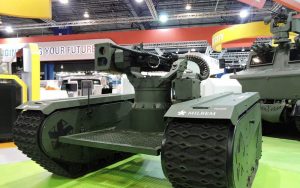
Here’s a video with the companies involved shown at the end. Here’s another video of the UGV in multiple terrains, weather conditions, and various configurations. And here’s a robot “dog” with, what the article claims, is a mounted Russian PP-19-01 “Vityaz” submachine gun.
The UGV looks fairly easy to de-track.
Janes, a military and intelligence trade journal, first reported the story. The UGVs were first deployed on September 12 and, according to the Dutch Ministry of Defense (MOD), are an experiment.
“We have deployed four weaponised [unmanned] machines within an operational experiment”, Lieutenant Colonel Sjoerd Mevissen, commander of the Royal Netherlands Army’s Robotics and Autonomous System, told Janes. “To my knowledge, we have not seen this before in the West…the machines have been handed over for experimental use in an operational unit in a military-relevant environment. These are not simply tests on a training ground. We are under the direct eyes and ears of the Russians, and as such in a semi-operational environment.”
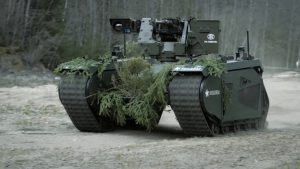
The machine-gun-toting robots aren’t the first the world has ever seen. Estonia first deployed an unarmed version of THeMIS in Mali in 2019. This Russian MoD confirmed it deployed armed UGVs in Syria in 2018. Iran has also been developing its own UGVs and showed off its Heidair-1 on social media in 2019. Iran’s small beetle-like drone seems designed to roll under tanks and APCs and explode.
There’s a lot of modularity to the design, which is good. It’s also helpful because they keep increasing the loadout of a soldier’s pack while lowering the physical standards. Perhaps each soldier should get, um, her own robot personal assistant. It was better when America was a serious country. In all seriousness, the modular design enabling conversion to various roles seems like a worthwhile feature.
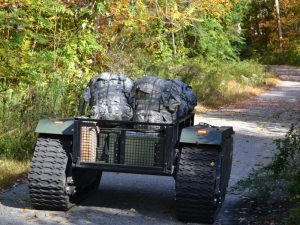
Both Russia’s Uran-9 and Estonia’s THeMIS are bigger and can carry more deadly equipment. The Uran-9 is capable of carrying a 30mm 2A72 automatic cannon and four 9M120-1 Ataka anti-tank guided missiles, which makes it look like a frightening and deadly killer robot. However, early reports indicate that Russia’s UGV didn’t work well in Syria and repeatedly lost connection to its controller.
Via Instapundit
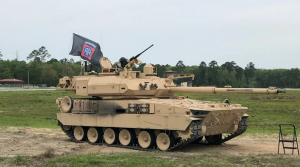
The Army awarded General Dynamics Land Systems a contract for its Mobile Protected Firepower light tank. (US Army photo)
Popular Science: Via Instapundit.
When it comes to crossing rivers on bridges, all the technology of modern warfare is still bound by the hard limits imposed by the laws of physics—the structure needs to be able to support the vehicle that’s on it. To try to cope with this problem, the Army is investing in a lighter tank than its current battlefield behemoth, the M1 Abrams main battle tank. This new vehicle, which is still known by its descriptive moniker Mobile Protected Firepower, was promoted at the Association of the United States Army conference held in Washington, DC, from October 10-12.
The Mobile Protected Firepower (MPF) vehicle weighs in at 38 tons, which is heavy by all standards, except it is light compared to the 70 tons of heft of an Abrams tank. That means it can go places the Abrams can’t, expanding how and where the Army can effectively fight war from vehicles. The MPF will also feature fire control and situational awareness sensors, which can allow enemy location data to be shared across vehicles in formation.
The MPF is designed to accompany Infantry Brigade Combat Teams, which are intended primarily for travel on foot. These formations, which consist of between 3,900 to 4,100 people, incorporate some vehicles, but are distinguished from Armored and Stryker Brigade Combat Teams, which use roughly heavy and medium-armored vehicles to transport soldiers and weapons around the battlefield.
Breaking Defense: (from June)
The Mobile Protected Firepower program is part of the Army’s Next-Generation Combat Vehicle portfolio, which is developing future ground vehicles as part of the services’ broader, multi-billion modernization effort that includes the Optionally Manned Fighting Vehicle.
Optionally Manned Fighting (ground) Vehicles and Unmanned Fighting (ground) Vehicles can now be added to the vernacular that includes UAVs.
The Army’s stated acquisition objective for the program is 504 vehicles. The first production vehicle will be delivered in “just under” 19 months, Dean said, a timetable that roughly hits around December 2023. That timeline is driven in part by the time it takes to get long-lead time parts, Dean said.
Moving into production, the Army and GDLS will have to be diligent to avoid supply chain issues as production ramps up. Dean said the program was already experiencing “challenges” in the supply base.
“We are seeing challenges in the supply base right now both in cost and availability [of] materials, as well as competition for other components, particularly in the electronic space where electronic chips are in big demand,” Dean said, adding the Army had “some comfort” because the proposals had “reasonable control” over their supply chain.
So, General Dynamics can’t get raw materials and parts; why? Aren’t these sourced entirely in the US? Building fighting machines based on a global JIT supply chain seems fairly idiotic. If there’s an actual war, not one of those banker’s wars, mind you, but a real war, how can the United States satisfy its national strategic interests if it can’t build fighting machines and field trained fighting men? America does not appear to be a serious power anymore. The best part of the top photo is the little step stool. Is that for Generals to look down the barrel?
Here’s a scale model from AUSA‘s recent trade show and exhibition:
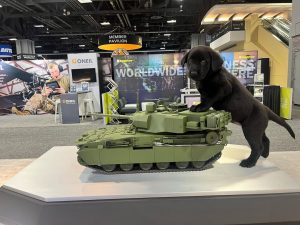
Also, at the show – (Why do we get the feeling many of these will be used in CONUS?)
AbramsX:
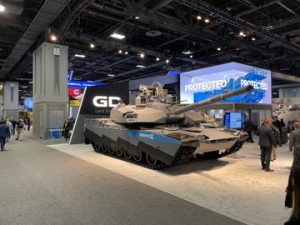
TRX Breacher:
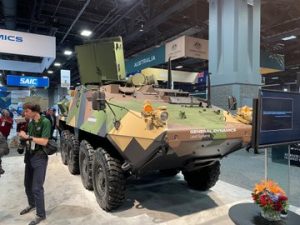
StrykerX:
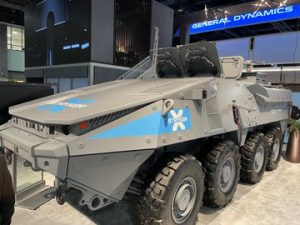
Stryker Leonidas:
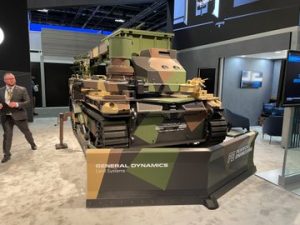
Better Photo of the Leonidas:
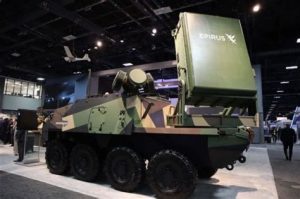
This video has apparently been making the rounds. Before we go any further, let me stipulate that I don’t know with certainty if this is really CAG or somebody playing tacticool during weekend at Bubba’s. It is alleged to be CAG. No one in the thread seems to be questioning that, and in fact, they seemed to think it’s pretty cool.
On the other hand, I’m appalled. It looks amateurish and silly. They hop off of a helicopter and clop around like cows for close to half a minute, making as much noise with the machinery and footsteps as possible. The players aren’t alerted to any presence despite the massive noise avalanche, they’re standing still, there are no trip wires to kill the team, they are out in the open with no cover or concealment, and it’s broad daylight.
If this was really a CAG practice mission, I would have expected face paint, no reflective lenses, dark clothing, entry by night along a treeline, use of NODS, and quiet approach to room entry execution that went off in two to three seconds and the rest of the building cleared in under ten seconds.
When my son was in the Marine Corps, including live fire shoot house training, when the training included Marine-on-Marine shooting they used chalk rounds. Those hurt from what I understand.
Why weren’t the actors moving? Why weren’t the actors shooting back with chalk rounds? Why wasn’t this real training rather than a waste of time and gasoline for the helicopter?
So as I stipulated, I don’t know with certainty that this is CAG. It could be weekend at Bubba’s. Somebody who can track this down please tell me this isn’t really CAG?
I’m left scratching my head at this whole thing.
CAG mock hostage rescue pic.twitter.com/BBATobjibK
— Travis (@GWOT5822) December 1, 2021
Here.
Lord help us if we ever get into a near-peer conflict.
The U.S. military is done. Finished. Kaput. It is no more. There is nothing left of it. It is a hollowed out shell.
UPDATE: NC Renegade posted yesterday. I missed that.
We are BEYOND fucked. pic.twitter.com/1wlJhZWQz0
— Nate Taylor: Kardashian Moat Lifeguard (@NotNateTaylor) October 18, 2021
Around the 4 second mark. That rifle is pointing everywhere but down.
Buses filled with National Guardsmen have arrived at the Brooklyn Center Police Department. pic.twitter.com/OL8dAbps8F
— James Klüg (@realJamesKlug) April 13, 2021
If my son had muzzle flagged somebody like that in the MC, he would have been sent to the “room of pain.” Oh, and it would be best not to drop your rifle. Keep better control over it.
Via WiscoDave.
Via WiscoDave. I don’t have a category for safety, so I’ll file this one under Army.
Dear NGUS personnel in Washington DC:
That piece of webbing on the front of the rifle running to the back is called a SLING.
It's so that you can carry the rifle, hands free, with the barrel oriented in a safe direction.
Signed: Marines
— Joe Dolio 🇺🇲 (@DolioJ) January 15, 2021


